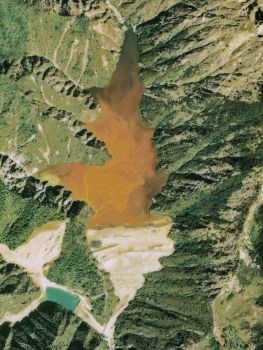Design and Construction of Tailings Dams: Difference between revisions
(Created page with "__NOTOC__ Category:Tailings Dams ---- {{Picture <!-- Add image file name (ex.image.jpg) --> |image= Sunokobashi_Tailings_Dam_1976.jpg <!--Add link if applicable --> |link= <!-- Add picture caption --> |caption= Aerial view of the Sunokobashi Tailings Dam. (Image Source: [https://mapps.gsi.go.jp/maplibSearch.do#1 Copyright © National Land Image Information]) }} Tailings dams are essential engineering structures designed to store and manage...") |
No edit summary |
||
| Line 22: | Line 22: | ||
Like all dams, [[Tailings Dams|tailings dams]] require regular maintenance and monitoring of seepage rates and [[settlement]] patterns. Being aware of these factors is crucial to identify and address any potential issues promptly. Periodic maintenance activities, such as [[Vegetation Management|vegetation management]] and repairs to erosion control measures, are essential to prevent erosion and maintain the stability of the dam over its lifespan. | Like all dams, [[Tailings Dams|tailings dams]] require regular maintenance and monitoring of seepage rates and [[settlement]] patterns. Being aware of these factors is crucial to identify and address any potential issues promptly. Periodic maintenance activities, such as [[Vegetation Management|vegetation management]] and repairs to erosion control measures, are essential to prevent erosion and maintain the stability of the dam over its lifespan. | ||
The construction of [[Tailings Dams|tailings dams]] has become increasingly environmentally focused. For instance, there is growing interest in utilizing alternative construction materials that have a reduced [[environmental]] impact. Increased collaboration between mining companies, engineers, and environmental experts is crucial to continually improve the design and construction practices of tailings dams. | The construction of [[Tailings Dams|tailings dams]] has become increasingly environmentally focused. For instance, there is growing interest in utilizing alternative construction materials that have a reduced [[environmental]] impact. Increased collaboration between mining companies, engineers, and environmental experts is crucial to continually improve the design and construction practices of [[Tailings Dams|tailings dams]]. | ||
==Best Practices Resources== | ==Best Practices Resources== | ||
{{Document Icon}} [[Safety of Dams: Policy and Procedures (ER 1110-2-1156)| Safety of Dams: Policy and Procedures (ER 1110-2-1156), USACE]] | {{Document Icon}} [[Safety Guidelines and Good Practices for Tailings Management Facilities (ECE 1326665) | Safety Guidelines and Good Practices for Tailings Management Facilities (ECE 1326665), UN]] | ||
{{Document Icon}} [[Safety of Dams: Policy and Procedures (ER 1110-2-1156) | Safety of Dams: Policy and Procedures (ER 1110-2-1156), USACE]] | |||
{{Document Icon}} [[Tailings Management: Good Practice Guide | Tailings Management: Good Practice Guide, ICMM]] | |||
Latest revision as of 15:09, 21 August 2023

|
| Aerial view of the Sunokobashi Tailings Dam.
(Image Source: Copyright © National Land Image Information) |
Tailings dams are essential engineering structures designed to store and manage the waste materials generated from mining operations. They protect the environment by preventing the release of harmful substances into surrounding ecosystems. The design and construction of tailings dams require careful planning and engineering expertise to ensure their stability, long-term integrity, and minimal impact on the environment.
Tailings are the byproducts of mining activities and typically consist of a mixture of water, fine particles, and residual chemicals. If not managed properly, tailings contaminate water, destroy habitats, and release toxic substances. Therefore, the design and construction of tailings dams must focus on containing these materials safely and preventing their release into the environment. Failure events are always catastrophic, including notable events such as the collapse of Brumadinho Dam in Brazil, a disaster that cost 270 lives.
When designing a tailings dam, engineers must consider factors such as the volume and characteristics of the tailings, site conditions, and local climate. The dam's foundation must be evaluated to ensure its stability and resistance to seepage. Additionally, factors like the height and slope of the dam, as well as the choice of construction materials, liners, and drainage systems are taken into account. The design should also incorporate safety measures, such as monitoring systems and emergency spillways, to mitigate the risks associated with dam failure.
During the construction phase, dam materials are compacted carefully to achieve the required strength and density. Special attention is given to the construction of the dam walls, which may involve layering different materials to enhance stability and prevent seepage. Adequate compaction of the tailings is essential to minimize the risk of liquefaction, which frequently causes dam failure.
Like all dams, tailings dams require regular maintenance and monitoring of seepage rates and settlement patterns. Being aware of these factors is crucial to identify and address any potential issues promptly. Periodic maintenance activities, such as vegetation management and repairs to erosion control measures, are essential to prevent erosion and maintain the stability of the dam over its lifespan.
The construction of tailings dams has become increasingly environmentally focused. For instance, there is growing interest in utilizing alternative construction materials that have a reduced environmental impact. Increased collaboration between mining companies, engineers, and environmental experts is crucial to continually improve the design and construction practices of tailings dams.
Best Practices Resources
![]() Safety Guidelines and Good Practices for Tailings Management Facilities (ECE 1326665), UN
Safety Guidelines and Good Practices for Tailings Management Facilities (ECE 1326665), UN
![]() Safety of Dams: Policy and Procedures (ER 1110-2-1156), USACE
Safety of Dams: Policy and Procedures (ER 1110-2-1156), USACE
